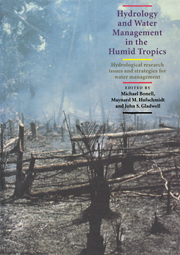 Hydrology and Water Management in the Humid Tropics
Hydrology and Water Management in the Humid Tropics Book contents
- Frontmatter
- Contents
- List of Authors
- Foreword by Federico Mayor, Director-General, UNESCO
- Preface
- Cartographic Credit
- Acknowledgements
- SECTION I INTRODUCTION
- SECTION II HUMID TROPICS SETTING
- SECTION III REGIONAL HYDROLOGY
- 5 Hydrology in Humid Tropical Asia
- 6 The Hydrology and Water Resources of Humid Northern Australia and Papua New Guinea
- 7 Hydrology and Water Resources of Tropical Latin America and the Caribbean
- 8 Amazonia Rainfall and Its Variability
- 9 Regional Hydrology and Water Resources in the African Humid Tropics
- 10 Review of Hydrology and Water Resources of Humid Tropical Islands
- SECTION IV PHYSICAL PROCESSES
- SECTION V PHYSICAL PROCESSES – HUMAN USES: THE INTERFACE
- SECTION VI MANAGEMENT ISSUES
- SECTION VII APPENDICES
- Place index
6 - The Hydrology and Water Resources of Humid Northern Australia and Papua New Guinea
Published online by Cambridge University Press: 23 December 2009
- Frontmatter
- Contents
- List of Authors
- Foreword by Federico Mayor, Director-General, UNESCO
- Preface
- Cartographic Credit
- Acknowledgements
- SECTION I INTRODUCTION
- SECTION II HUMID TROPICS SETTING
- SECTION III REGIONAL HYDROLOGY
- 5 Hydrology in Humid Tropical Asia
- 6 The Hydrology and Water Resources of Humid Northern Australia and Papua New Guinea
- 7 Hydrology and Water Resources of Tropical Latin America and the Caribbean
- 8 Amazonia Rainfall and Its Variability
- 9 Regional Hydrology and Water Resources in the African Humid Tropics
- 10 Review of Hydrology and Water Resources of Humid Tropical Islands
- SECTION IV PHYSICAL PROCESSES
- SECTION V PHYSICAL PROCESSES – HUMAN USES: THE INTERFACE
- SECTION VI MANAGEMENT ISSUES
- SECTION VII APPENDICES
- Place index
Summary
ABSTRACT
This paper reviews the hydrology and water resources of the humid tropical regions of Papua New Guinea and Australia. Topics covered include rainfall, evaporation, runoff, water quality and water management issues.
INTRODUCTION
The UNESCO Colloquium on the Development of Hydrologic and Water Management Strategies in the Humid Tropics adopted the Chang and Lau (1983) definition of humid tropic regions. This definition identifies areas where the mean temperature of the coldest month is above 18°C and the duration of the wet season exceeds 4.5 months. A wet month has on average more than 100mm of rainfall. When the average monthly rainfall is between 60 and 100 mm, half a wet month is allocated.
Under this definition, approximately 12% of Australia and 93% of Papua New Guinea can be classified as humid tropics. This paper provides a general description of the region and then more detailed information on the rainfall, evaporation, water balance, soil moisture, runoff, water quality, design flood and streamflow estimation procedures.
GENERAL DESCRIPTION OF REGION
Papua New Guinea
Half of the land area of Papua New Guinea is above 1,000 metres, with the highest point 4,500 metres (Fig. 1). The central range of the main island, which runs unbroken from the tip of the southeast peninsula to the border with Irian Jaya in the west, has only two passes lower than 1,500 metres. In places, the cordillera broadens into a series of parallel ridges separated by high, flat, intermontane valleys. Many aspects of the topography indicate geological youth: ungraded rivers, V-shaped valleys, waterfalls, cliffs and frequent land slippages (Proctor, 1988).
- Type
- Chapter
- Information
- Hydrology and Water Management in the Humid TropicsHydrological Research Issues and Strategies for Water Management, pp. 67 - 83Publisher: Cambridge University PressPrint publication year: 1993
- 3
- Cited by


